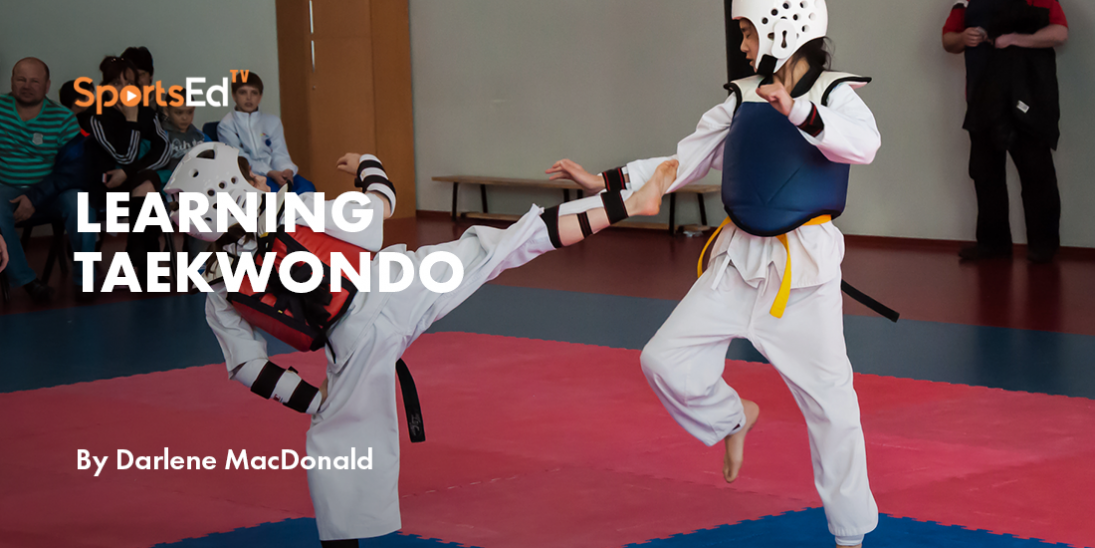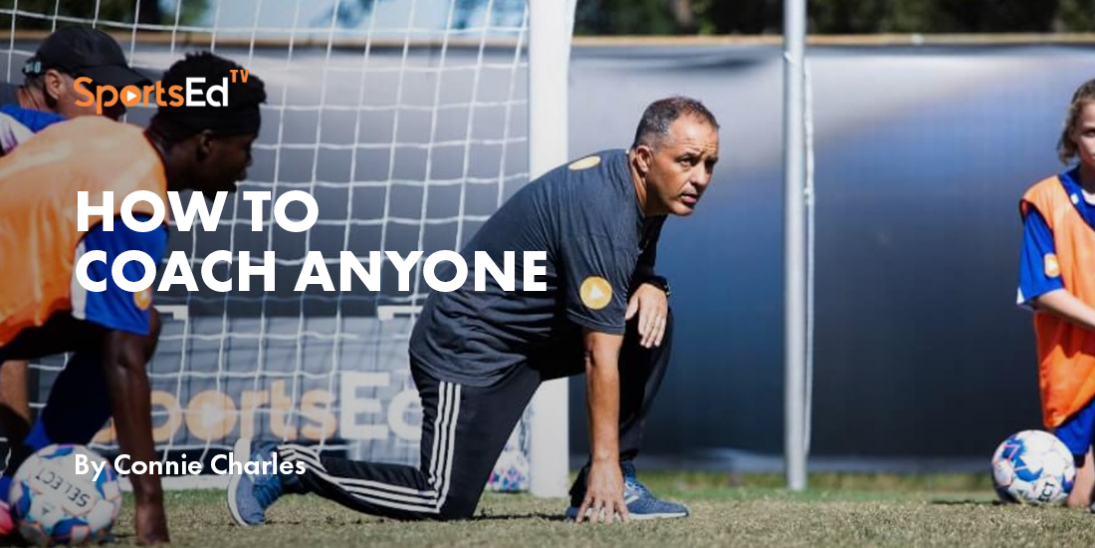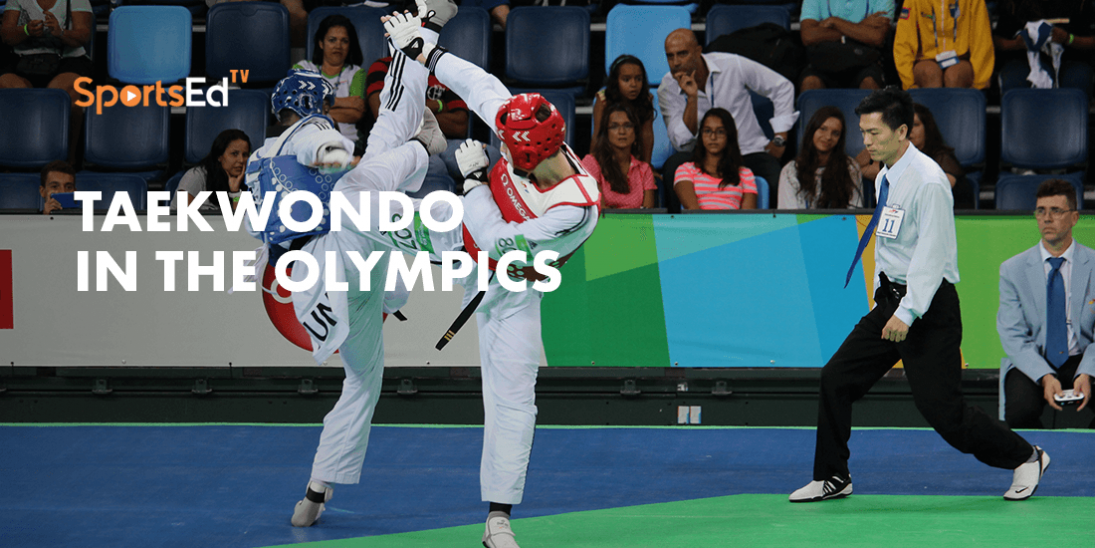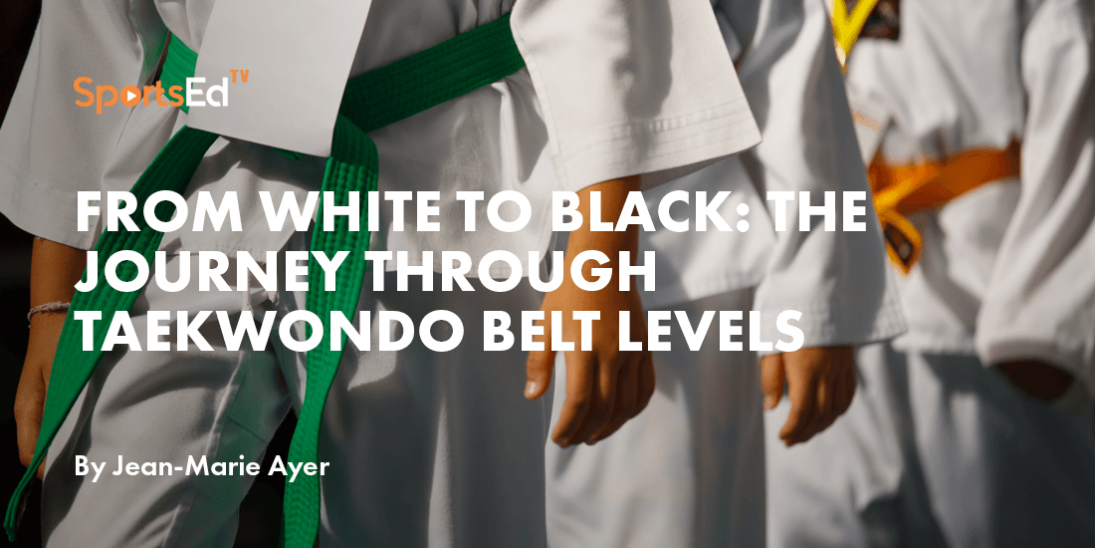Taekwondo
Welcome and thanks for visiting...

Choosing Taekwondo
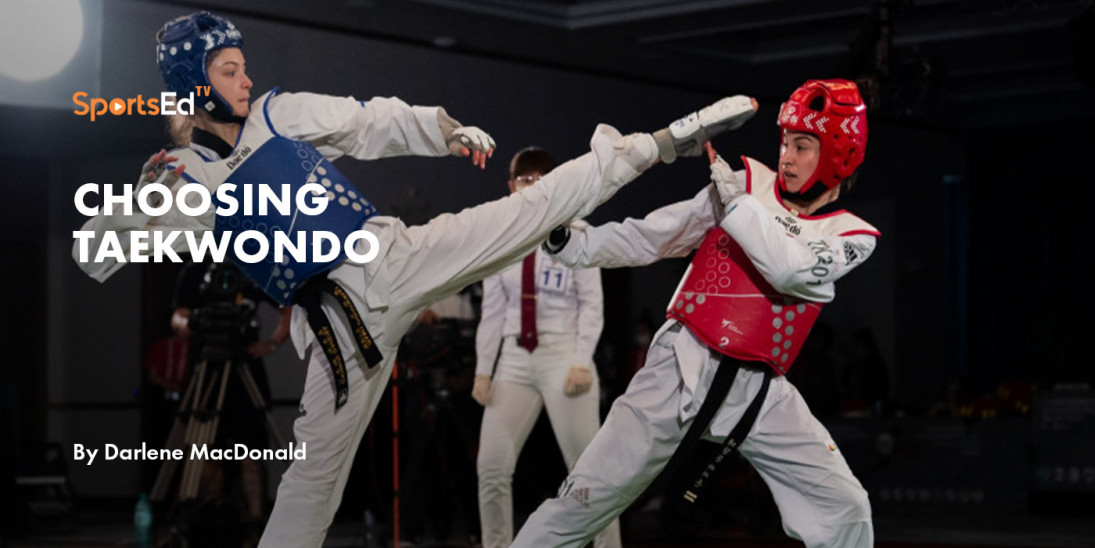
If you want to try a new sport or activity, how do you choose?
The Global Association of International Sports Federations has 99 member sport associations listed on its website. Some of those members represent different sports, for example the Fédération Internationale de natation (FINA) represents multiple water sports like swimming, water polo, diving, etc., and The Fédération internationale de ski (FIS) represents cross country skiing, ski jumping, snowboarding, etc. So out of 99+ sports, how are you supposed to choose what to get involved with when you are looking for a new sport or activity to try?
Many people try certain sports because their friends and family introduce them to it, because it’s nearby or convenient, because it’s popular, or because they have somehow been drawn to it. For millions of people around the world the activity that they have chosen is the martial art and sport of taekwondo.
Taekwondo is still quite young. As an international organization, World Taekwondo was formed in 1973 as the World Taekwondo Federation (WTF) and underwent a name change in 2017, because, well, WTF. Because of the work of many people and influence in the sporting world, taekwondo became an official event of the Olympic Games at the 2000 Sydney Olympic Games, a mere 27 years after the international federation was formed. According to World Taekwondo, there are 210 Member National Associations (http://www.worldtaekwondo.org/about-wt/about.html, retrieved 2021 03 20) and millions of practitioners worldwide.
So, the question remains as to why people may choose to become involved in taekwondo over other activities. As a combat sport and martial art, there are many reasons someone may choose to practice taekwondo, including physical, tactical, cultural, financial, social, and other reasons, but first, what is taekwondo?
Taekwondo 101
Taekwondo is a martial art that originated in Korea in the 20th century. The place you go to for taekwondo practice is called a dojang (ëì¥). The dojang owner is called kwanjangnim (ê´ì¥ë) while a taekwondo instructor is called sabumnim (ì¬ë²ë). The main areas of practice in taekwondo are poomsae (forms), kyorugi (sparring), gyeokpa (breaking) and hoshinsul (selfâdefense).
Taekwondo specializes in kicking. That includes single kicks, combination kicks, spinning kicks, jumping or aerial kicks, footwork and kicking, punching and kicking, blocking and kicking, kicking as defense, kicking as offense, kicking to the mid-section, kicking to the high-section, kicking with the right leg, kicking with the left leg, kicking while moving the body forward, kicking while moving the body backward, kicking while moving the body to the side… you get the point. If you’re interested in learning how to kick, then it’s worthwhile checking out taekwondo classes.
Taekwondo is an amazing exercise activity that includes the whole body. Kicking and footwork works the lower part of the body, including the big muscles of the thighs; punching and blocking works the upper parts of the body; and the consistent need for balance and the dynamism of the sport continually works the core.
Competition
Taekwondo is a martial art and combat sport. There are mainly two types of sport competition in taekwondo, kyorugi and poomsae.
Kyorugi competition is the type of sport competition that is included in the Olympic Games but there are also world championships, regional championships, national championships, regional championships, regional Games and many national and local championships. Kyorugi competitions are usually individual matches that are separated by female and male weight divisions. There are also a few age groups competitors are separated by, e.g. cadet, junior, senior. The competitors wear protective equipment and matches last for three rounds of two minutes each with a one minute break between rounds. If there is a tie at the end of the match then another round is included where the winner is the player who scores first.
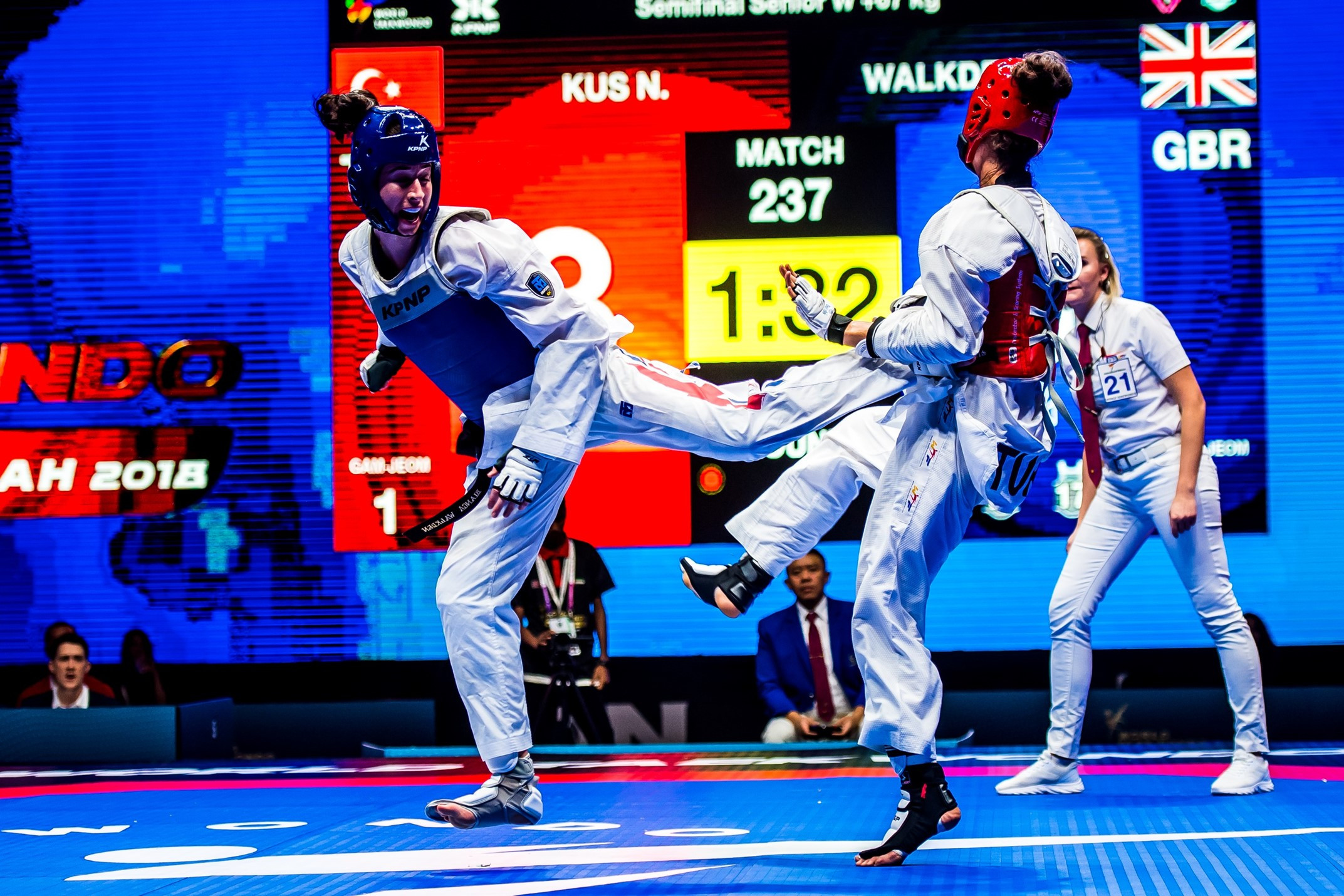
The goal is to finish the match with more points than your opponent or to knock out your opponent. To end with more points you need to score on your opponent and stop your opponent from scoring on you so that when the match is finished you have scored more points than your opponent. In taekwondo competition, you must hit your opponent with a minimum power threshold on the body to score points. On the head the requirement for points centre more around accuracy rather than power. Depending on the location and the difficulty of the technique you can gain 1 to 5 points for a single technique.
Poomsae competition is when an individual, duo, or team performs a series of predetermined movements that may demonstrate kicks, punches, blocks, jumps, and footwork and the performers are judged on a scale up to a maximum of 10. Those with the highest score wins.
At the elite, international level of competition, there has been a World Taekwondo Championships that initially consisted of kyorugi matches for men, since 1973. The World Taekwondo Championships that included kyorugi matches for women have been held since 1987. World Taekwondo World Cup Team Championships originated in 2006, while the World Taekwondo Poomsae Championships also originated in 2006 and included both men and women. The World Taekwondo Para Championships originated in 2009 and also included both women and men. Local competitions vary on what may be offered. Typically, there is kyorugi and poomsae, but there may be only one event offered and there may be additional events as well, for example para taekwondo matches, breaking competitions, self defense, and sometimes even weapons competition, a non-traditional taekwondo event that has been influenced by other martial arts.
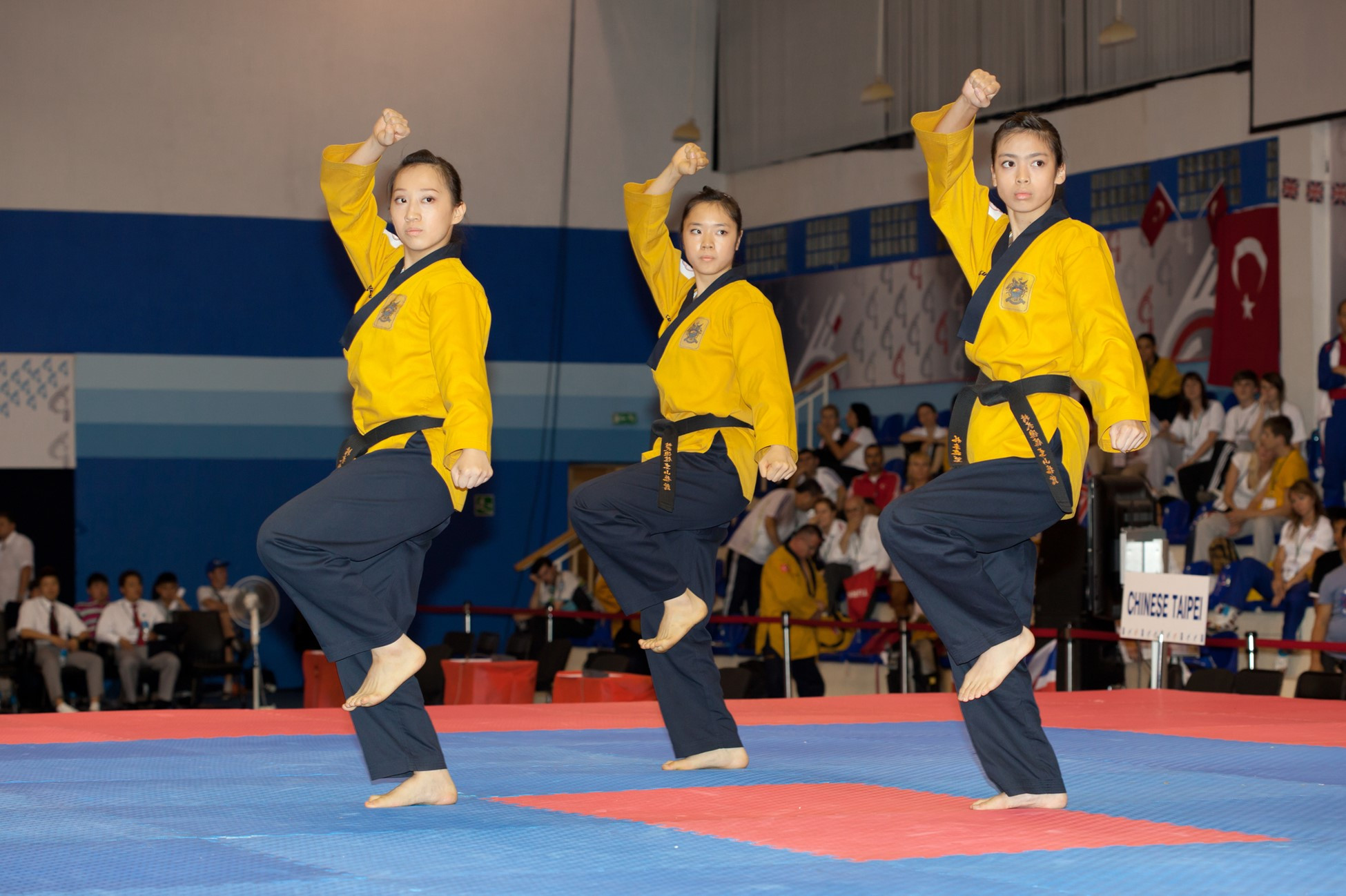
There are many people who join taekwondo because they want to learn it specifically but there are also those who join as a supplement to a more favoured activity, or those who join because they want an activity they can do with their friends or family members. Let’s have a brief look at some of the factors people may decide to choose taekwondo.
Physical skills
With learning any activity there are two factors that may greatly affect your skill development and physical progress: 1. what your instructor/coach focuses on and leads you in doing, and; 2. the effort that you contribute.
Different dojangs may offer classes that, more or less, help build your cardiovascular capacity; some that, more or less, help build your strength; some that provide, more or less, intense workouts; and some that have more or less breaks. Some instructors focus more on kyorugi while others prefer to focus more on poomsae. Whatever the preference at your local dojang, the skills you can expect to develop while practicing taekwondo include power, speed, reaction time, coordination, agility, balance, flexibility and cardiorespiratory fitness.
Kicking practice, kicking drills, jumping, and plyometric drills involve the stretch shortening cycle of the muscles of the thighs and legs, which help to increase power in the practitioner. These and other drills, not to mention kyorugi practice, will also help increase speed. Perhaps kyorugi may not directly focus on speed but when you face off against another athlete and you can’t quite deliver that kick you think you perfected then you will understand a few things about combat, not the least of which is that in many situations kicking faster and building your speed is important to combat success. Increasing speed also helps overcome any deficiencies that may be present in reaction time. Furthermore, taekwondo training is an activity that uses drills, along with competition, that consistently works on reaction time.
Since taekwondo movements use the whole body, you can expect improvement in the coordination of gross motor skills, especially with regular practice. Additionally, hand (or foot)-eye coordination should improve. A common drill in taekwondo classes is to kick a target. Similarly, drills may be used for simultaneous blocking and punching, all of which improves coordination. Through the dynamic training of taekwondo, a practitioner can expect their agility to increase. A training component of taekwondo that helps in this regard is a focus on footwork and the importance of weight distribution. Practitioners may learn to step forward, sideways, or backwards followed by kicking, blocking, or punching, or perhaps all of these almost simultaneously. Furthermore, taekwondo athletes may also opt to work on moving forward, sideways, or backwards while they are kicking, blocking, or punching.
One look at a taekwondo athlete and you will recognize the necessity to develop the skills of balance and flexibility. When a taekwondo athlete is in the middle of an action they are often standing on only one leg. If you look at top poomsae athletes, their ability to perform high kicks with picture perfect balance is incredible. For some people, kicking well and keeping balance may initially be difficult but with continued practice the skills developed, such as power, coordination, balance, flexibility, etc. turn both training and competitive performances into works of art, and that includes both poomsae and kyorugi performances.
Finally, taekwondo practice improves cardio respiratory fitness. In a research study of international taekwondo athletes, it was found that moderate to high levels of cardio-respiratory fitness are necessary for kyorugi athletes[1]. Participants of taekwondo tournaments come to realize the importance of both being able to endure and perform well through the full three rounds of a taekwondo match and being able to recover between multiple matches during the day. Increased cardiorespiratory fitness will help achieve these goals.
Clearly, for attaining and developing physical skills taekwondo practice is a great way to achieve goals.
Tactical
Taekwondo practice and kyorugi competition include both offensive and defensive strategies. Like other martial arts, it may be marketed as self defense but don’t let that mislead you. After all, as the proverb goes, the best defense is a good offense.
Offensive strategies are typically riskier but the offensive player has a better opportunity to set the tempo of the match and control the game, assuming the skill level of the players is similar. There are many ways to implement offensive strategies such as:
- Direct attacking
- Multiple or combination kicks
- Feinting and attacking
- Footwork set up and attacking
- Making a move in which you know your opponent likes to respond to so that you can get her or him into position for your counter attack
Defensive strategies typically come from a more stable position and have a higher rate of scoring specific points[2] in competition. A strategy commonly used for taekwondo players who are not familiar with their opponents is to employ more defensive tactics in the beginning of the match and wait until they can get some more information on their opponent before finalizing or adapting their strategy. Players may look at their opponent to understand their kicking and kicking leg preference, combination preference, balance, speed, timing, footwork, feints, or reach. Additionally, near the end of a match, if a player is winning in points an approach used often is to run out the time through the use of a defensive tactic in order to protect the lead and secure the win.
Financial
The cost of taking taekwondo classes can be variable, depending on where you take lessons. If you are lucky enough to have it offered in your school then perhaps the cost is either free or minimal. If you go to a community program it may be a little more, and if you go to a professional taekwondo dojang then lessons there may be the most you will pay for taekwondo classes in your area. It appears that taekwondo classes may be comparable to the average cost of other similar sports and activities (Note: this statement is an anecdote from personal observations and knowledge in multiple areas but I have in no way completed or cited any analysis of costs of taekwondo lessons.)
Other costs of taekwondo participation may include a dobok (uniform), testing fees, and protective equipment. At the very minimum, someone who wanted to learn taekwondo would need to find a place to practice and someone to teach them about taekwondo, so it can be quite inexpensive to learn; however, for elite athletes the financial cost can be quite high as they often travel the world attending competitions to gain ranking points toward achieving their Olympic dreams.
Social
Taekwondo can be both an individual activity or a team sport, so the good news is that participants can derive benefits of both, if they so choose. Initially, joining a taekwondo dojang and taking classes means that you are involved in an individual activity but working out with a group, class, or team. Kyorugi competition is mainly an individual combat sport. All around the world there are taekwondo competitions where one individual engages in taekwondo combat against another individual in the same weight category. There have been World Championships held since 1973. More recently, there has been a rise in offering team championships where there are multiple members on a team, e.g. five team members. In team matches, a team member who is competing may change with another team member to replace her or him during the match. There have been different versions of team championships offered and in 2006 the World Taekwondo Federation held the first World Cup Taekwondo Team Championships. Conversely, poomsae competition offers categories for individual contest or team events in recognized or freestyle poomsae events. In 2006, the World Taekwondo Federation held the first World Taekwondo Poomsae Championships and during the COVID-19 pandemic continued to hold poomsae championships, with online poomsae events.
Involving oneself in an individual sport allows you to develop mental toughness as you develop mastery of the activity. Since you are the only person to perform you must learn to focus and pay attention to detail in order to achieve technical proficiency. There is no one to cover for your weaknesses nor “pick up the slack”. All of the skills displayed is up to the individual. As a team member participants learn about cooperation and teamwork in order to achieve team goals. You don’t have to perform everything, rather you are just one part of the team solution, perhaps with special skills. For areas where your skills may be weaker, your teammates may contribute more. As a team member, you need to learn both when to lead and when to follow and recognize that all members of the team have a shared responsibility to each other for training, for performances, for failures, and for successes.
Cultural
Taekwondo is more than a martial art, sport, or activity. It is also a favoured export of Korean culture that people from countries outside of Korea can experience without travelling to the east Asian country.
Language
In the 1960s, 1970s, and beyond an exodus of Korean taekwondo practitioners moved to countries around the world and started sharing their expertise and sharing their culture through taekwondo instruction.
Many practitioners have been taught commands, words, and counting while at the taekwondo dojang. As soon as the class starts, taekwondo students are taught to start the class by standing at attention and showing respect to the instructor by bowing with the commands charyut (ì°¨ë ·), and kyeong-neh (ê²½ë¡). Class exercises may be completed in unison by counting together from one to ten in Korean, e.g. hana (íë), dul (ë), set (ì¸), net (ë¤), da sut (ë¤ì¯), ya sut (ì¬ì¯), il gop (ì¼ê³±), yu dul (ì¬ë), a hop (ìí), yul (ì´). Commands and terminology are often expressed using Korean words, e.g. dwi chagi (back kick), ul gool makki (high block); and in competition the referee commands are all in Korean, e.g. begin (shijack); break (kalyeo).
The Korean alphabet, or Hangul (íê¸) is easy to read, if you are so inclined to learn, since it was developed as a phonetic system. Speaking Korean; however, is a lot more difficult.
Customs
In Korean culture, it is very important to show your respect to elders or higher rank. In taekwondo, it is also expected to show your instructor, elders, and higher ranks proper respect. One way this can be expressed is through bowing and also answering respectfully, such as saying “yes sir” or “yes ma’am”.
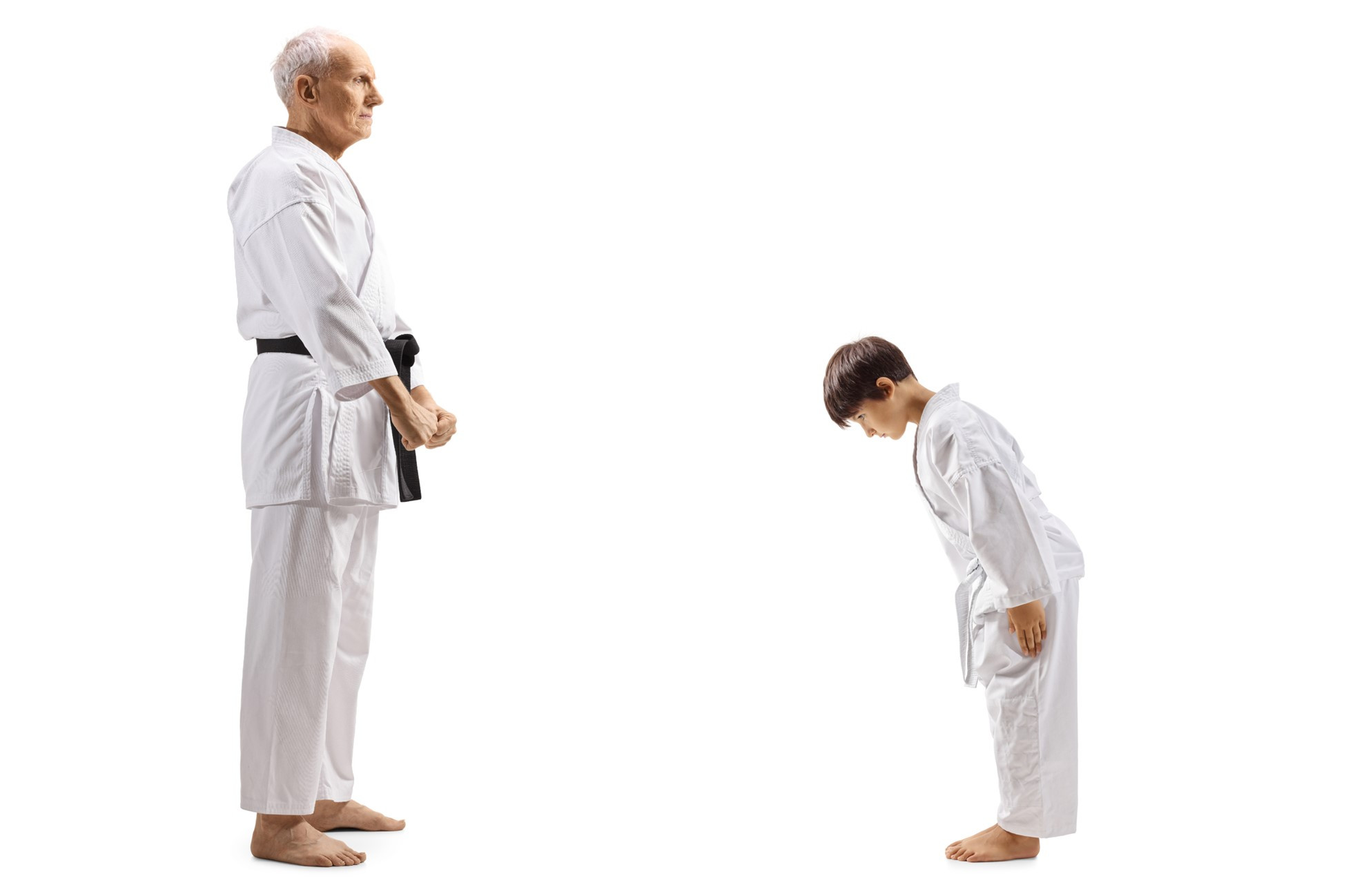
Another example of a custom is the removal of footwear when entering a house. Cleanliness of floors is very important in Korea, since people often sit on floors when eating meals or socializing. The heated floors (ondol) in Korea can be very comforting. In taekwondo, it is expected for practitioners to take off their footwear upon entering the dojang. There should be no outdoor shoes on the practice floor.
A final example is the polite giving and receiving of things to others. It is a sign of respect that you give your attention to someone who you are dealing with rather than to just haphazardly or absent-mindedly pass along or impatiently receive something. In this vein, giving and receiving things should be completed with both hands, most especially when dealing with your seniors or elders. This custom may be practiced in dojangs as well.
Food
If you keep practicing taekwondo long enough then sooner or later you will most likely be exposed to Korean food. Sooner is better! Korean food is REALLY delicious and with the variety of dishes available, you should be able to find something you like. Actually, Korean food has nothing to do with taekwondo, other than it is a good thing to consume after your workout. Some delicious dishes to try are: the national dish of Korea, kimchi; some meat or seafood dishes like bulgogi, gamjatang, or ojingeo bokkeum; soups like kimchi jiggae; samgyetang, or tteok manduguk; noodles like jjajangmyeon, jjapchae, or naengmyeon; rice and vegetable based dishes like bibimbap or kimbap; or other snacks like mandu or tteokbokki. If you are looking for a dessert there are many different kinds but anything with black bean paste in it is typically very tasty. If you would also like to try Korean traditional alcohol perhaps soju or makkoli will give you a taste of Korea.
Other
This list certainly isn’t a comprehensive list of the benefits of taekwondo and reasons why one may be drawn to the activity. Taekwondo gives the practitioner a sense of empowerment over their own abilities, over their own body, and over their own environment. The sport is pretty young, less than a century, but has spread worldwide and is ever evolving. For those who prefer some structure in their activities, taekwondo classes are led by instructors that organize and direct each aspect of the class.
Whether you are looking for an activity or sport that offers physical skill development, tactical engagement, cultural exposure, manageable financial commitments, various social opportunities, or perhaps other beneficial reasons, taekwondo involvement may be the right choice. It certainly is and has been for millions of people around the world.
[1] (Bridge, C. A., da Silva Santos, J. F., Chaabène, H., Pieter, W., & Franchini, E. (2014). Physical and Physiological Profiles of Taekwondo Athletes. Sports Med 44, 713–733. https://doi.org/10.1007/s40279-014-0159-9)
[2] Menescardi, C., Estevan, I., Ros, C., Hernández-Mendo, A., & Falco, C. (2021). Bivariate analysis of taekwondo actions: The effectiveness of techniques and tactics in an Olympic taekwondo championship. Journal of Human Sport and Exercise, 16(1), 199-211. doi:https://doi.org/10.14198/jhse.2021.161.18

